Awhile back, Lisa Lise did a fascinating series of posts experimenting with glucomannan as a plant-based carbomer alternative that inspired me to do some gelling experiments of my own. It’s funny, I’ve been cooking with some of these gums for years, but it never once occurred to me to smear any of them on my face!
I decided to make an eye gel incorporating my all-time favorite skincare ingredient, the marshmallow root, but to do that, I needed to understand more about the different natural polysaccharides at my disposal for creating a water-based gel.
Which one(s) will give me the thick, creamy, but lightweight texture I’m looking for?
How much should I use?
Which one feels the best on the skin?
Inquiring minds want to know!
The contestants:
- acacia senegal gum (aka gum arabic)
- agar agar
- chia seed
- flax seed
- glucomannan
- guar gum
- Siligel™
- sclerotium gum
- xanthan gum
- sodium hyaluronate/hyaluronic acid
I was already somewhat familiar with Lucas Meyer’s “green” gelling agent, Siligel (a commercial blend of xanthan gum, lecithin, sclerotium gum and pullulan) but I do not love how it smells, plus, it never gave me the thick, scoop-it-out-with-your-fingers gel that I was going for. Using Siligel’s 2% recommendation as a starting point, I prepared 2% samples of glucomannan, xanthan gum, agar, guar gum, gum arabic, sclerotium gum and Siligel (as the control) using 50 g distilled water : 1 g powdered gelling agent. The gum arabic solution was mixed at 6% because I’d read that’s the minimum concentration that will yield a “weak gel.”
24 hours later, the results of the experiment were pretty interesting.
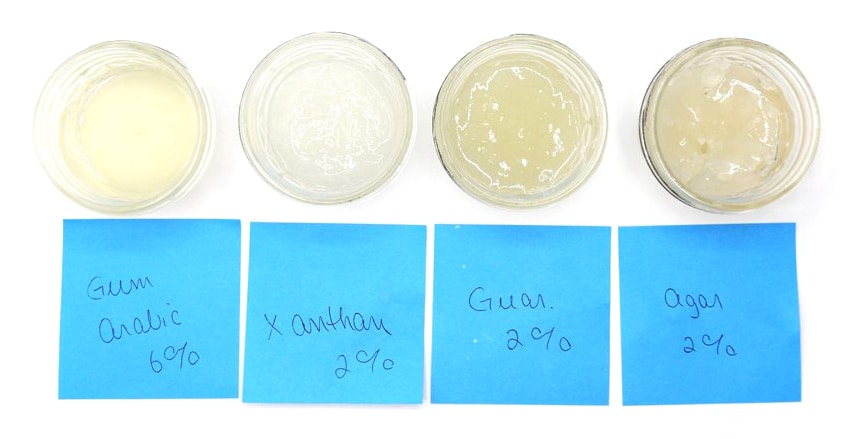
From a texture and skin feel standpoint, I felt that xanthan and guar gums were the winners of this round. Both produced a translucent, smooth, silky textured gel that wasn’t overly firm and easily scoopable. The xanthan gum had a slightly creamier texture and was mostly colorless, while the guar gum was a firmer (but still scoopable) and had a distinct yellowish hue. Both had some issues with feeling somewhat tacky and pilling up if too much gel was used.
The glucomannan created, by far, the most attractive, crystal clear gel, but it had a significantly tackier skin feel and the gel was way too firm at 2%. It had a much nicer, soft gel texture at 1%, but still felt quite tacky on the skin.
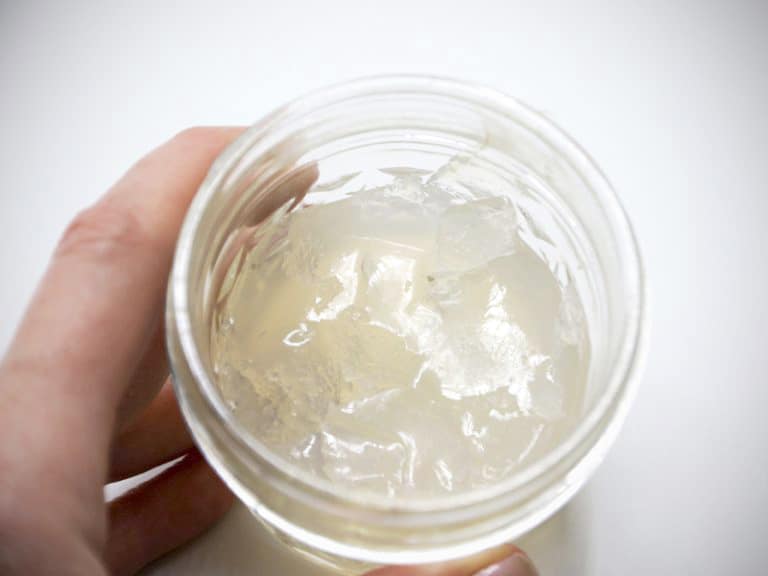
The agar agar powder (pictured above) produced the firmest results of all of the gels. It resembled extremely firm jello with a smooth, glass-like surface that you had to punch through with your finger to scoop out the product. 1% agar yielded slightly less firm results, but I still had to punch through the surface to get to the product. They were pretty to look at, but perhaps not right for this application.
The gum arabic sample at 6% made the water slightly viscous, but never really gelled at all. I guess when they said “weak gel” they weren’t kidding, lol. It remained a runny, yellowish liquid but with a silky skin feel. Upon further research, it appears that gum arabic forms a thin, slightly viscous film forming liquid that isn’t quite right for what we’re doing here, but its emulsifying ability could be very handy for formulas containing essential oils (or small amounts of other oils) that need to remain liquid. Cool beans! You better believe the gears are already turning, planning a future gum arabic project!
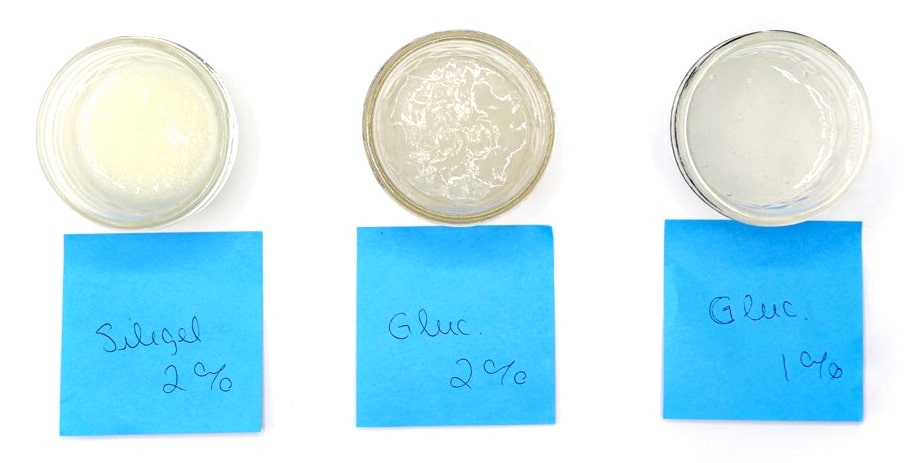
The Siligel control produced a yellowish medium-viscous solution that resembled a lotion more than a gel. It was also the only sample that had a detectable scent.
For the most part, I liked the texture and skin feel produced by the 2% xanthan gum sample, but it was a bit tacky and had a tendency to pill, (i.e. form little balls of clumped product when rubbed into the skin) and I wanted a slightly thicker, slightly more stable end product. Maybe xanthan would perform better mixed with another gum (or gums)?
Yup, a new round of testing is in order.
Round 2
It seemed logical that adding a smidge of glucomannan to the xanthan gum might produce a gel with the feel of xanthan but with a bit more of glucomannan’s structure and body. I tried a 1/4 glucomannan : 3/4 xanthan gum blend at 2% that looked pretty nice and had good body, but it retained too much of the tackiness I didn’t like about the all-glucomannan samples. I liked the results of the 1/10 glucomannan : 9/10 xanthan gum 2% sample better. It had the structure I was looking for with a better skin feel. For some reason, both xanthan/glucomannan blends turned whitish and more opaque than their non-blend counterparts.
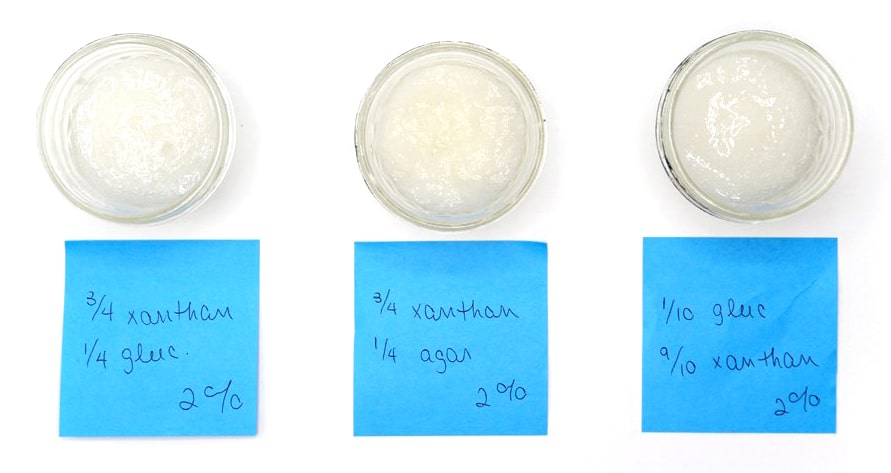
I also tried adding a bit of agar to the xanthan at 1/4 agar : 3/4 xanthan gum. The result was soft, transparent gel with a rather unpleasant, grainy texture:
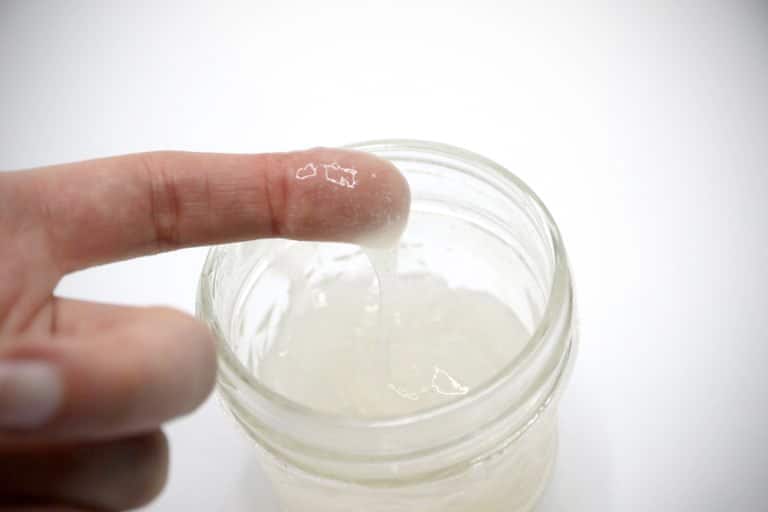
Nope.
3/4 xanthan : 1/4 guar gum was ever so slightly yellower than the mostly clear all-xanthan gum sample, but it retained xanthan’s nicer texture and decent skin feel while having a bit more body.
Getting closer!
Xanthan gum increased to 2.5% (pictured above) was an improvement over 2%. The translucent, colorless gel sat up better at 2.5% than at 2%, but obviously, it retained the slight tackiness and pilling issues of the 2% sample.
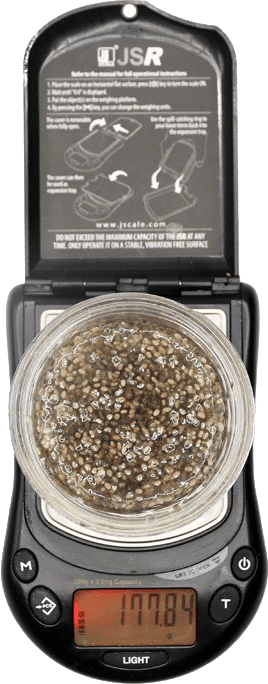
For funsies, I also made gels from flax and chia seeds, since they’re both common ingredients in homemade natural hair gel recipes, and they’re both full of anti-inflammatory, emollient and demulcent properties. For this experiment, I used 50 g water : 1 tablespoon chia seed and 50 g water : 1 tablespoon flax seed. I heated each sample to boiling and then left them on the counter overnight. In the morning, I used a small nylon mesh bag to separate the seeds from the mucilage.
These gels were far weaker than those made from the gums – basically thick, viscous goo – but I think they have potential if paired with another “co-gel.” Next time, maybe I’ll try grinding the seeds before adding them to the water to maximize the extraction. I was able to squeeze about 2 tablespoons of goo from the flax seed sample, but try as I might, the chia seeds just wouldn’t give up their gel, and I barely squeezed 1/4 teaspoon out of the chia seed sample. Maybe I should have used fewer seeds or more water, but I’m thinking chia seeds may work better as an exfoliant in a formula where the seeds remain in the product.
I hadn’t originally planned on including it, (and I forgot to take a picture — doh!) but it also occurred to me to try a 1% sample of sodium hyaluronate, since I already knew it had thickening and stabilizing properties from my face serum recipes. 1% sodium hyaluronate created a really lovely, crystal clear gel with the silky skin feel you would expect from hyaluronic acid. It’s not designed to be a stand-alone gelling agent, (and would be a stupid-pricy one if it was) but it has tons of potential when combined with something else like xanthan gum or glucomannan to give it more body.
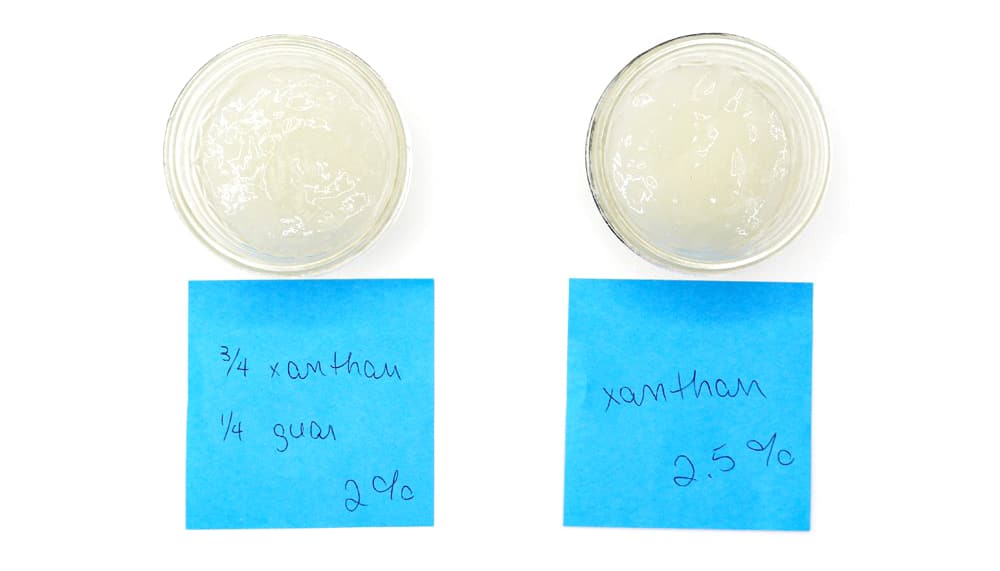
Right about the time I was wrapping up the second round of samples and preparing to declare 2.5% xanthan the winner, ̶m̶y̶ ̶r̶i̶n̶g̶e̶r̶ my sclerotium gum order arrived in the mail, and I immediately mixed up a sample. At 2% it produced a translucent gel with a lovely, silky skin feel that disappears into the skin and didn’t feel “tight” after drying when tested it on my wrist. The sclerotium gum texture was close to perfect, but depending on your formulation goals, it may need a bit more body/structure. It’s also quite pricy compared to the other gelling agents.
I tried a 50-50 blend of sclerotium and xanthan gums, hoping to find a balance between gelling properties and skin feel, while conserving my expensive sclerotium gum. Not bad! The xanthan provided the body that sclerotium lacked on its own, while maintaining the silky skin feel.
The final test was a 2% blend of 1/2 sclerotium, 1/4 xanthan and 1/4 gum arabic. This sample was my favorite. It really nailed the sweet spot balancing texture, skin feel and economy. Ding ding ding…
We have a winner!
I was having so much fun mixing gels, I probably would have kept going if I hadn’t run out of jars. Out of 19 trials, the 1/2 sclerotium, 1/4 xanthan, 1/4 gum arabic and the 1/2 sclerotium, 1/2 xanthan gels tied for the win.
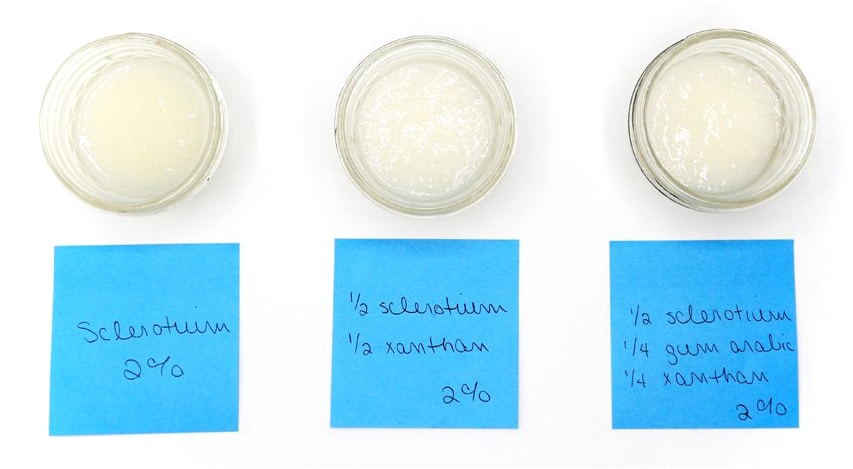
Depending on what you’re trying to accomplish, though, I think many of these combos may have a time and a place. For example, guar gum is still a top contender for a future hair gel recipe, particularly because it’s the main gum in my favorite store-bought hair gel.
Gum arabic is already my film-former of choice for mascara formulations, as it’s reputed to be a soothing, anti-inflammatory ingredient that’s easy on the eyes. (literally and figuratively!) Now that I understand more about gum arabic’s quirks and properties, I’m excited to try it as an emulsifier in my next spray-on product.
A sodium hyaluronate-heavy eye gel would be lovely, possibly paired with a smidge of glucomannan for structure, skin tightening and beautiful, crystal clear gelling properties.
I would probably favor a xanthan gum-heavy formula in any recipe designed to be washed off, since sclerotium would be expensive overkill for a product not intended to remain on the skin. Xanthan’s slight tackiness and pilling issues probably wouldn’t be an issue here.
So much to think about! Did my little experiment inspire you to try a new gel project? Leave a note in the comments! ♥
Recipes using gums
Marshmallow Root Soothing Repair Gel
Gentle Yucca Root Shaving Gel

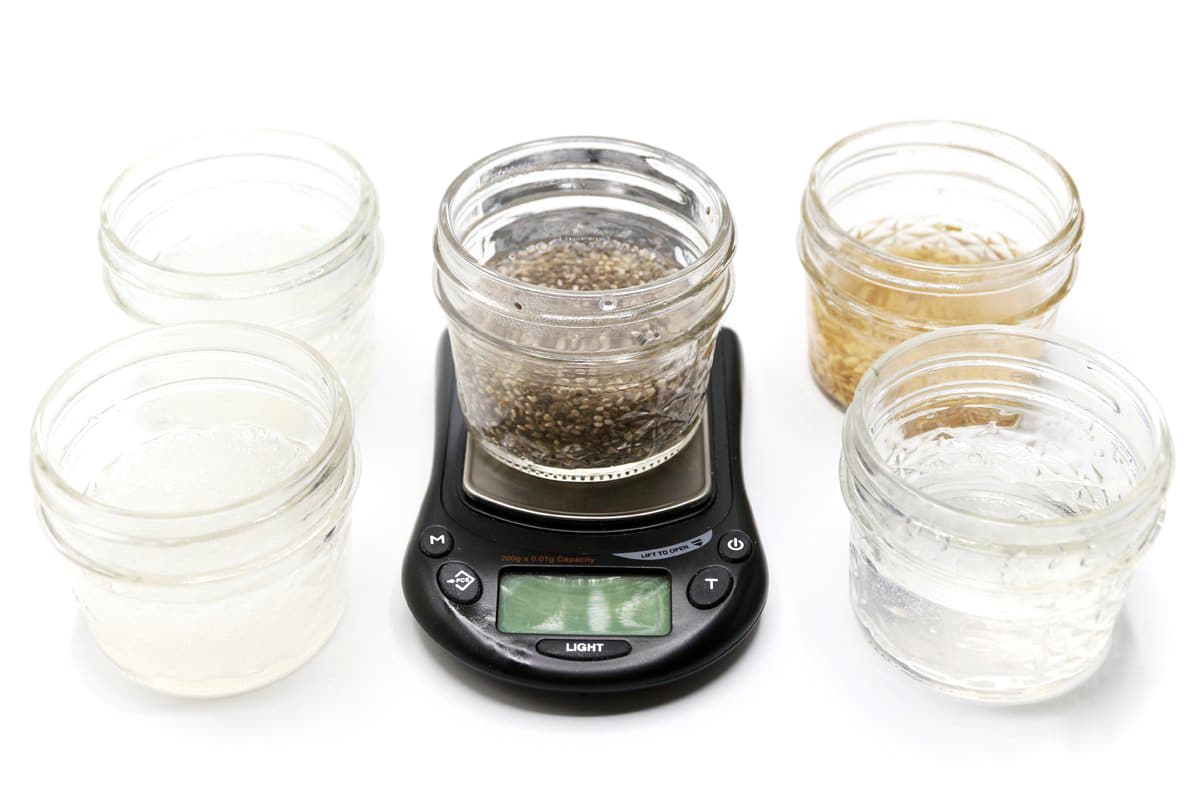


One Response
What an excellent test on gels. Thank you for documenting and sharing this!
I am curious about your experience with pilling. That’s the one reason I avoid using gels in serums. They tend to cause pilling when a cream, sunscreen, or foundation is layered on top. I have tried, Xanthan clear, HEC, Sepimax Zen, & Hyaluronic Acid.